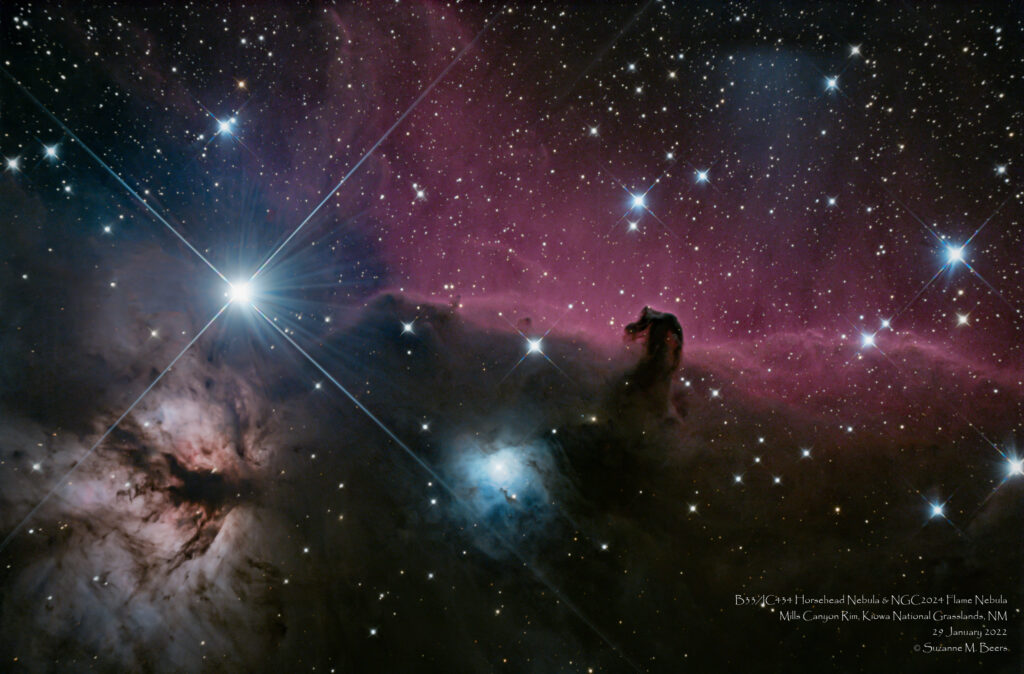
Fun facts
The B33 Horsehead Nebula is a small dark nebula in the Orion constellation. The nebula is located just to the south of Alnitak, the easternmost star of Orion’s Belt, and is part of the much larger Orion molecular cloud complex. It appears within the southern region of the dense dust cloud known as Lynds 1630, along the edge of the much larger, active star-forming H II region called IC 434.
The Horsehead Nebula was discovered by Scottish astronomer Williamina Fleming in 1888 on a photographic plate taken at the Harvard College Observatory. One of the first descriptions was made by E. E. Barnard, describing it as: “Dark mass, diam. 4′, on nebulous strip extending south from ζ Orionis”, cataloguing the dark nebula as Barnard 33.
The NGC 2024 Flame Nebula is an emission nebula. The bright star Alnitak (ζ Ori), the easternmost star in the Belt of Orion, shines energetic ultraviolet light into the Flame and this knocks electrons away from the great clouds of hydrogen gas that reside there. Much of the glow results when the electrons and ionized hydrogen recombine. Additional dark gas and dust lies in front of the bright part of the nebula and this is what causes the dark network that appears in the center of the glowing gas.
Other Catalog Designations: Barnard 33, LDN 1630, IC 434 (Horsehead); NGC 2024, Sharpless 277 (Flame)
Subtype: Dark Nebula (Horsehead); Emission Nebula (Flame)
Distance from Earth: 1500 light years
Visual Magnitude: 6.8 (Horsehead); 10 (Flame)
Radius: 3.5 light years (Horsehead); 6 light years (Flame)
Constellation: Orion
{from: https://en.wikipedia.org/wiki/Horsehead_Nebula and https://en.wikipedia.org/wiki/Flame_Nebula}
Personal Fun Fact
This image was awarded second prize in the Astronomical League Williamina Fleming Imaging Award in the Deep Space Object category! (https://www.astroleague.org/content/williamina-fleming-imaging-award)
Equipment
Polar alignment: QHYCCD camera (controlled by Polemaster)
Imaging stream: Orion 8″ f/8 Ritchey-Chretien Astrograph Telescope; Canon EOS Ra with with Teleskop Service Flattener 1.0x for RC Telescopes (TS-RCFLAT2) and Optilong L-Pro light pollution filter
Mount: Sky-Watcher EQ6-R Pro Equatorial Mount (controlled by EQMOD)
Autoguider: Orion 60mm Multi-Use Guide Scope, Orion StarShoot AutoGuider Pro Mono Astrophotography Camera (controlled by PHD2)
All equipment controlled by HP Probook running Sequence Generator Pro v3.2.0.660.
Capture & processing notes
Sequence plan: ISO1600; 40x300sec + 25x30sec (for Alnitak) Notes: Captured, 29Jan2022, 1843MST – 2235MDT. Total exposure time: 3:20 hrs.
Capture: 29 January 2022
Shooting location: Mills Canyon, Kiowa National Grasslands, New Mexico
Processing: Stacked (5min in one stack, 30 sec in another) with Astro Pixel Processor (APP). Processed as layers in Photoshop.
